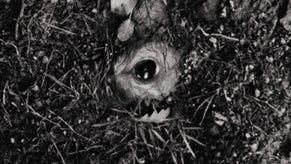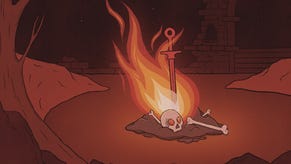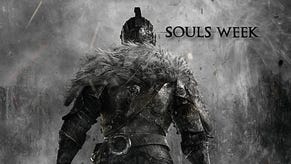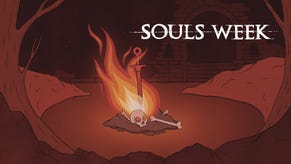Face-Off: Dark Souls 2
From hell.
Out with the old and in with the new, Dark Souls 2 offers up the biggest technical overhaul to the series so far. With a new directorial team at the helm and a purpose-built engine bringing the eerie world of Drangleic to life, developer From Software uses the opportunity to trial new rendering techniques on PS3 and 360 in advance of their appearance on next-gen platforms. But while we're left with a string of upgrades in physics, lighting and effects, there are also some cutbacks we hadn't expected to see.
Straight away we can pinpoint a clear technical advance in Dark Souls 2's resolution of choice, where it's now a full native 1280x720 on both PS3 and 360. On paper this should count as a massive boon to its presentation, but in practice the boosted pixel count only faintly improves image clarity over the original Dark Souls' 1024x720 frame-buffer. A reliance on a post-process edge filter is to blame: it's an effective aliasing-killer, but many highlights in texture-work and alpha effects are dulled, and on both Sony and Microsoft platforms alike the game produces a softer image than we'd hoped. Nevertheless, it's an improvement - and a positive start as we venture deeper into a game world that promises to be the team's largest yet.
On reining in our lossless captures for close analysis, we find visual differences between the two versions are few and far between. In a nutshell, the greatest advantage on the PS3 side is its superior texture filtering, where the cut-off distance on 360 is much closer - causing a blur to appear on floors at a nearer proximity for that platform. Perhaps more noticeable is the 360's own advantage, where higher resolution alpha effects are in place for bonfire flames, exploding projectiles and waterfalls. These effects appear to run with cut-down levels of detail on Sony's platform, which creates more pronounced aliasing artefacts when overlapping with nearby geometry.
In isolation these are easy to miss however, and it's worth stressing that geometry and texture quality are entirely like-for-like between the two last-gen releases. For a closer inspection, please check out our head-to-head video below, and also our 70-image Dark Souls 2 comparison gallery.
"In terms of image quality, PlayStation 3 offers clear texture filtering advantages while Xbox 360 has higher resolution transparency effects."
While both versions are neck-and-neck for the most part, it's the comparison with the original Dark Souls that proves more intriguing. For starters, common to both platforms is a brand new lighting model. This allows effects such as crepuscular rays - streams of light bursting around a building's outline - to be proudly shown off under Majula village's low-key sunset. A new dynamic lighting system is also in place to encourage the use of torches in darker areas, where an absence of ambient light in No Man's Wharf creates an unexpected gameplay hook. The knock-on effect is that the player now casts massive shadows around bonfires, which can look odd when a silhouette twitches erratically across cavern walls.
It's fair to say these shadows are not a pretty sight, especially given the harsh aliasing to their edges on both versions. This is something we hope the delayed PC version might clean up - though given the developer's barebones approach to its last port, expectations should be carefully managed here. The revised engine has been designed with DirectX 11 support in mind however, and the developer confirms options for higher frame-rates and superior textures. Anything above and beyond that anything extra counts as a welcome surprise.
Another big addition to Dark Souls 2 on consoles is ambient occlusion. This fills the small crevices, corners and divots to the game world with a light shade to create a sense of depth. It's easiest to spot under grass tufts from a distance, but unfortunately for the wrong reasons: a distracting shimmer effect is easy to spot when panning the camera around. Even so, it's a big technical step forward for the series, where foliage in particular looked a touch plain in the original Dark Souls.
Last but not least, we also have physics-based rendering, implemented here with a mind to build on these systems once the engine moves to Xbox One and PS4. This time the series utilises Morpheme technology to simulate body motions on weapon impacts, as also seen in games like Grand Theft Auto 5. The last-gen versions also benefit from Havok cloth physics, meaning tunics and robes flap and sway with each step, and castle flags flutter overhead.
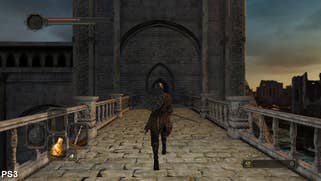
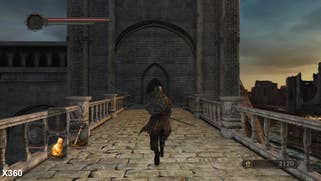

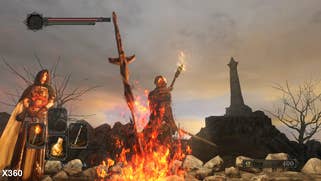



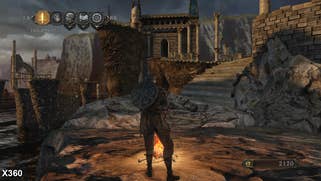






But all of these extra come at a cost, the most noticeable being its uses of detail culling. Just as with Dark Souls, this sequel prides itself on offering seamless transitions between each area. From one end of the world to the other, there are no loading screens to interrupt the adventuring - only enemies. This time, level-of-detail (LOD) scaling is aggressively used to avoid rendering scenery, shadow maps and enemies that are far out of your camera's view. This is a smart cost-saving trick, and one that helps the game avoid single-digit frame-rates seen in Dark Souls' Blight Town.
The only issue here is that the LOD scaling sticks out like a sore thumb. Extra geometric elements across rocky outcrops and houses now pop into view quite obviously as you draw closer. Worse still is the way shadow maps beneath smaller objects appear just metres away - and turning a corner too sharply causes enemies to abruptly flicker into view. It makes Drangleic feel less like a consistent living world while your perspective has shifted, and marks a big visual downgrade from the original Dark Souls.
Equally disappointing is what could have been. Early PS3 beta footage of the game shows a massive overhaul in scenery lighting has taken place, particularly in the Cardinal Tower on show. Most changes can be argued as being purely in the interest of aesthetic preference - such as a mossy flourish being added to the area. However, it's hard to ignore the removal of a giant 'soul ball' alpha effect when claiming souls, the reduction in lit torches, and that some rocky wall textures are replaced by flatter, blander variations in the final product. It's a revised look that lessens the emphasis on pitch black environments too, leaving us with dungeons that rely less on the torch lighting mechanic.
For all the engine tweaks and compromises, Dark Souls 2's performance remains surprisingly uneven. Unlike previous games, both PS3 and 360 versions run with no frame-rate cap whatsoever. Stuttering ensues as a result when the game rises above the 30fps line, but each version still suffers from drops below this around the usual scenarios. When smashing up the physics-based scenery, faced with excessive alpha, or framing a long view of complex areas like Majula, the lowest recorded result on PS3 is 14fps (during a barrage of bomb explosions), while the 20fps mark is the lowest on 360 (while passing through a fogged doorway).
"Xbox 360 commands a substantial lead in raw frame-rate, but the experience is blighted owing to ever-present screen-tear that is not present on the v-synced PS3 version."
There's no doubt the 360 version gives the smoother experience overall though, with an average advantage of 10fps during gameplay and cut-scenes. As a result, controller input translates more fluidly to the on-screen action, but the catch is that the Microsoft release offers no v-sync to back this up. Copious amounts of tearing break up the integrity of the image wherever you go - and the brighter the area, the more noticeable this becomes. The PS3 version on the other hand gets away scot-free with no tearing, thanks to its utilisation of v-sync, though once again the stuttering frame-rates make this version difficult to recommend as a perfect alternative.
Dark Souls 2: the Digital Foundry verdict
All of which leads us to a crossroads when recommending one version over the other. On the one hand, if you can't bear the thought of playing through a Dark Souls game with heavy tearing, the PS3 version is the only way to go for now. Performance is largely a sub-30fps affair for Sony's console, but thanks to an engine revamp with more aggressive LOD scaling, we have yet to experience sustained drops as egregious as the original Dark Souls at its worst. For the smoothest performance though, the 360's ability to push 30-40fps at most points is worth considering among those tolerant of tearing artefacts.
It's not a clear-cut answer then, and to top it off, there are some other minor considerations. Both games run at the same resolution with identical assets, though superior alpha effects on the 360 counts as a positive for that console. The better texture filtering on PS3 is a curious plus for Sony's platform also, and its free online service may be enough to curry favour among regular PvP players. Either way, throughout the rebuilding of its engine, this looks, plays and feels like a Dark Souls game, and fans will be well served by the core experience on either platform.
For those stubbornly waiting on PS4 or Xbox One versions, From Software is staying strictly mum on any next-gen details - besides acknowledging that this technology will form the bedrock of future efforts. The upcoming PC release will at least demonstrate the improvements planned for the game's textures and frame-rate - and whether that could extend elsewhere. As a cheeky aside for PS3 owners, the PS4 controller works impeccably with Dark Souls 2 with a wired connection. For now, that's about as close to a next-gen version as we're going to get.
You'll face the same punishing content whichever platform you play on. We've got a Dark Souls 2 walkthrough to get you through the worst of it.





